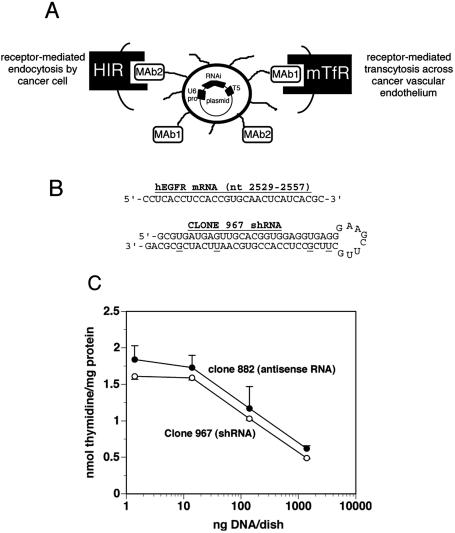FIG. 5.
Delivery of EGFR RNAi genes with pegylated immunoliposomes. A: Model of PIL that is doubly targeted to both the mouse transferrin receptor (mTfR) with the 8D3 monoclonal antibody (mAb1) and to the human insulin receptor (HIR) with the 8314 monoclonal antibody (mAb2). Encapsulated in the interior of the PIL is the plasmid DNA encoding the shRNA, which produces the RNAi. The gene encoding the shRNA is driven by the U6 promoter (pro) and is followed on the 3′-end with the T5 termination sequence for the U6 RNA polymerase. B: Nucleotide sequence of the human EGFR (hEGFR) sequence between nucleotides 2529 and 2557 is shown on top. The sequence and secondary structure of the shRNA produced by clone 967 is shown on the bottom. The antisense strand is 5′ to the eight-nucleotide loop, and the sense strand is 3′ to the loop. The sense strand contains 4 G/U mismatches to reduce the Tm of hybridization of the stem loop structure; the sequence of the antisense strand is 100% complementary to the target mRNA sequence. C: Human U87 glioma cells were incubated with [3H]-thymidine for a 48 h period that follows a 5-day period of incubation of the cells with HIR mAb-targeted PILs carrying either clone 967 or 882 plasmid DNA. A dose of 1.4, 14, 140, or 1400 ng plasmid DNA per dish was used in each experiment. Data are mean ± SEM (n = 3 dishes). Reproduced with permission41 (see Table 1 legend).

